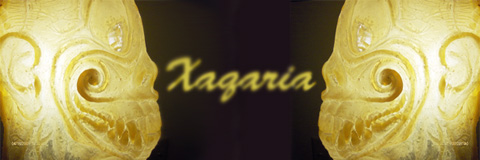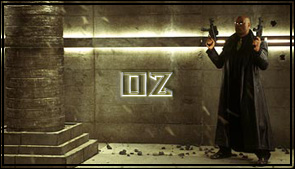This is why I don't understand the search for 'earth like planets'. We assume that life requires the specific conditions that lead to our existence, when life most likely springs up in so many varying circumstances that we can hardly even conceive of them all, and it is probably a lot more common than we currently imagine. |
|
Results 1 to 25 of 26
Hybrid View
-
04-23-2010 07:18 AM #1Drivel's Advocate



- Join Date
- May 2007
- LD Count
- WhoIsJohnGalt?
- Gender

- Location
- Denver, CO Catchphrase: BullCockie!
- Posts
- 5,589
- Likes
- 930
- DJ Entries
- 9
Art
The ability to happily respond to any adversity is the divine.
Dream Journal Shaman Apprentice Chronicles
-
04-23-2010 09:50 AM #2
I guess the average view of a "life form" on another planet, is that it is something visible by the naked eye.
 Like ET or something. Wouldn't be expecting life forms like that in gas giants or floating balls of acid.
Like ET or something. Wouldn't be expecting life forms like that in gas giants or floating balls of acid.
The Ultimate Lucid Mp3 Thread Link
Mp3 track available here (02/2015): http://www27.zippyshare.com/v/36261038/file.html
-
04-23-2010 11:14 AM #3
-
04-23-2010 12:09 PM #4
The Ultimate Lucid Mp3 Thread Link
Mp3 track available here (02/2015): http://www27.zippyshare.com/v/36261038/file.html
-
04-23-2010 01:40 PM #5"O" will suffice. Achievements:










- Join Date
- Apr 2005
- LD Count
- 20+ Years Worth
- Gender

- Location
- Central Florida
- Posts
- 16,083
- Likes
- 4032
- DJ Entries
- 149
Micro organisms have always been our main expectation - as far as I know. What's changed now (exponentially) is the various types of environments we can accept as possible to find them.
 Dream Journal: Dreamwalker Chronicles Latest Entry: 01/02/2016 - "Hallway to Haven" (Lucid)(Or see the very best of my journal entries @ dreamwalkerchronicles.blogspot)
Dream Journal: Dreamwalker Chronicles Latest Entry: 01/02/2016 - "Hallway to Haven" (Lucid)(Or see the very best of my journal entries @ dreamwalkerchronicles.blogspot)
-
04-23-2010 10:03 AM #6"O" will suffice. Achievements:










- Join Date
- Apr 2005
- LD Count
- 20+ Years Worth
- Gender

- Location
- Central Florida
- Posts
- 16,083
- Likes
- 4032
- DJ Entries
- 149
I agree. And while I understand the logistics of "well, we don't want to invest time and effort into searching for anaerobic life-forms, when all complex life-forms we know of are aerobic", I just find it kind of disappointing that the idea has never really even seemed to be considered, until now.
Anyway, awesome find. I hope this greatly expands the scientific paradigm of "what constitutes life." I'm sure it will. Only time will how much, though. Dream Journal: Dreamwalker Chronicles Latest Entry: 01/02/2016 - "Hallway to Haven" (Lucid)(Or see the very best of my journal entries @ dreamwalkerchronicles.blogspot)
Dream Journal: Dreamwalker Chronicles Latest Entry: 01/02/2016 - "Hallway to Haven" (Lucid)(Or see the very best of my journal entries @ dreamwalkerchronicles.blogspot)
-
04-23-2010 01:52 PM #7Banned


- Join Date
- Aug 2005
- Posts
- 9,984
- Likes
- 3084
-
04-25-2010 10:57 AM #8Drivel's Advocate



- Join Date
- May 2007
- LD Count
- WhoIsJohnGalt?
- Gender

- Location
- Denver, CO Catchphrase: BullCockie!
- Posts
- 5,589
- Likes
- 930
- DJ Entries
- 9
Obviously I can't argue with you, because their is no evidence. I just find it incredibly hard to believe that life formation is restricted to the presence of a relatively small collection of atoms and molecules. Just judging on the variety of patterns that have formed on this planet, it seems like a logical step to assume that there is an even greater variety out in the cosmos. It is my opinion that there are forms of life that we cannot even imagine, and that we may not even recognize as life if we were confronted by it.
Art
The ability to happily respond to any adversity is the divine.
Dream Journal Shaman Apprentice Chronicles
-
04-25-2010 11:18 AM #9
This reminds me of an interesting point, which is that when you look at the gritty details, it's actually rather hard to find a clear definition of what separates life from non-life. So in a very real way, we decide more or less arbitrarily what is alive and what isn't. It's not so much a matter of recognition as it is definition.
This following paragraphs are an illuminating passage from Michael Brooks's book "13 things that don't make sense." Here's a link to the chapter this comes from on Google Books.
--------------------------------------------------
How would you define life? Is it when a system reproduces itself? If that is the case, plenty of computer programs could be called alive, while plenty of people--sterile men and women, for example, or nuns--could not. Things that are alive consume fuel, move around, and excrete waste products, but so do automobiles, and no one would call them alive.
Schrodinger came to the conclusion that life is the one system that turns the natural progression of entropy, moving from order to disorder, on its head; living things are, effectively, things that create order from disorder in their environment. This, to him, was the essence of the process that staves off the state of death. It is still not enough, though; a candle flame creates order from disorder in its environment and is patently not alive.
The physicist Paul Davies has perhaps done most to try to elucidate a definition of life, but he too remains stumped for a final answer. Instead, he considers life to have various characteristics, none of which defines life in and of itself, and many of which can also be seen in nonliving matter. In his award-winning book The Fifth Miracle, Davies lists these attributes--and their failings--as explanations or descriptions of life, rather than definitions. A living being metabolizes, processing chemicals to gain itself energy (as does Jupiter's Great Red Spot). It reproduces itself (but mules don't, and bush fires and crystals do). It has organized complexity--that is, it is composed of interdependent complex systems such as arteries and legs (in this way it is rather like modern cars). It grows and develops (as does rust). It contains information--and passes that information on (like computer viruses). Life also shows a combination of permanence and change--evolution through mutation and selection. Finally, and perhaps most convincingly for Davies, living beings are autonomous; they determine their own actions.
Others have added to the list. A living system must also be contained within a boundary that is part of the system, according to biologist Lynn Margulis. Whichever way you look at it, though, the definition--or rather the series of suggestions and characteristics--is too vague to be really useful.
-
04-25-2010 10:59 PM #10Banned


- Join Date
- Aug 2005
- Posts
- 9,984
- Likes
- 3084
I used to say roughly the same things, but changed my mind as I learnt more about science. I think we will definitely recognise life when we see it; any lifeform in this universe is going to be some kind of collection of chemicals which derives chemical energy from its surroundings to make copies of itself.Obviously I can't argue with you, because their is no evidence. I just find it incredibly hard to believe that life formation is restricted to the presence of a relatively small collection of atoms and molecules. Just judging on the variety of patterns that have formed on this planet, it seems like a logical step to assume that there is an even greater variety out in the cosmos. It is my opinion that there are forms of life that we cannot even imagine, and that we may not even recognize as life if we were confronted by it.
I can't personally think of any good arguments that abiogenesis should be particularly easy.
I'm quite a believer in the idea of multiverses, where a huge number of universes exist, but only a tiny fraction of those have the correct fundamental constants for any kind of structure at all (the constants in our universe can only deviate a miniscule amount before the formation of molecules becomes impossible), and then only a tiny fraction of those have some form of life, and then only a tiny fraction of those have complex, conscious life, and so on.
In this probabilistic anthropic framework it seems quite possible that life can only arise out of a very specific combination of factors in an individual universe; i.e. the chances of the constants of a single universe happening to create two rather different methods of abiogenesis, when the chances of only creating one is very low, is itself very low.
Sure, many different organisms with quite different metabolisms have arisen, but it would seem they have all done so from a common ancestor (based on several factors like the consistency of codons or stereoisomers), which might suggest further that abiogenesis is very specific.
-
04-26-2010 01:04 AM #11Drivel's Advocate



- Join Date
- May 2007
- LD Count
- WhoIsJohnGalt?
- Gender

- Location
- Denver, CO Catchphrase: BullCockie!
- Posts
- 5,589
- Likes
- 930
- DJ Entries
- 9
That is interesting. The more I learned about science, the more I began to think that there is absolutely nothing special about us at all. Throughout the course of scientific history, arguments based on the uniqueness of our situation have all turned out to be egocentric rationalizations. The more we learn, the more insignificant we become. I personally believe that we are even far less significant than we currently believe; and life being as rare as you suggest would contradict that.
Even the philosophical idealogy that you apply to the world betrays your bias towards things that are similar to yourself. The anthropic principle is based squarely on the assumption that life has to be similar to us. Using that terminology is basically circular reasoning. You are saying that life has to be similar to us because we live in a universe in which life has to be similar to us. Even if you only apply the very basic definition of the concept, all it amounts to is a tautological argument; the universe must support our kind of life because we live here. This doesn't preclude the existence of other forms of life.
Interestingly enough, I found a very pertinent quote in the Hawking article that Dajo posted in your Alien Life thread;
 Originally Posted by Lord Rees, Astronomer Royal
Originally Posted by Lord Rees, Astronomer Royal
Last edited by Xaqaria; 04-26-2010 at 01:14 AM.
Art
The ability to happily respond to any adversity is the divine.
Dream Journal Shaman Apprentice Chronicles
-
04-26-2010 01:53 AM #12Banned


- Join Date
- Aug 2005
- Posts
- 9,984
- Likes
- 3084
Why are you asserting that I gave anthropocentric arguments? Because I used the word 'anthropic' in passing? The anthropic principle is the true statement that we can only observe universes where there exist beings capable of observation. It has nothing to do with anthropocentricism. Nothing was remotely anthropocentric about my post, I gave arguments based on physical evidence and logic.
I suggested that there may be billions of other universes with totally different systems of emergence which could lead to totally different complex sub-systems which could be classified as 'life', which if anything is the complete opposite of the rationale behind heliocentricism and other flawed arguments based on anthropocentric reasoning.
Unless Lord Rees gave an example of how else complex structure could arise from the substrates of our universe, that quote is only an assertion and so is rather pointless.Last edited by Xei; 04-26-2010 at 01:56 AM.




 2Likes
2Likes LinkBack URL
LinkBack URL About LinkBacks
About LinkBacks




 Reply With Quote
Reply With Quote



Bookmarks